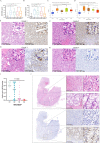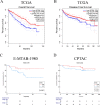Dynamic changes of SCGN expression imply different phases of clear cell renal cell carcinoma progression
- PMID: 38831128
- PMCID: PMC11147981
- DOI: 10.1007/s12672-024-01071-4
Dynamic changes of SCGN expression imply different phases of clear cell renal cell carcinoma progression
Abstract
The secretagogin (SCGN) was originally identified as a secreted calcium-binding protein present in the cytoplasm. Recent studies have found that SCGN has a close relationship with cancer. However, its role in the occurrence, progression, and prognosis of clear cell renal cell carcinoma (ccRCC) remains unclear. In this study, we utilized a mutual authentication method based on public databases and clinical samples to determine the role of SCGN in the progression and prognosis of ccRCC. Firstly, we comprehensively analyzed the expression characteristics of SCGN in ccRCC in several public databases. Subsequently, we systematically evaluated SCGN expression on 252 microarrays of ccRCC tissues from different grades. It was found that SCGN was absent in all the normal kidney tissues and significantly overexpressed in ccRCC tumor tissues. In addition, the expression level of SCGN gradually decreased with an increase in tumor grade, and the percentage of SCGN staining positivity over 50% was 86.7% (13/15) and 73.4% (58/79) in Grade1 and Grade2, respectively, while it was only 8.3% (12/144) in Grade3, and the expression of SCGN was completely absent in Grade4 (0/14) and distant metastasis group (0/4). Additionally, the expression of SCGN was strongly correlated with the patient's prognosis, with the higher the expression levels of SCGN being associated with longer overall survival and disease-free survival of patients. In conclusion, our results suggest that reduced expression of SCGN in cancer cells is correlated with the progression and prognosis of ccRCC.
Keywords: Biomarker; Heterogeneity; Occurrence; Prognosis; SCGN; ccRCC.
© 2024. The Author(s).
Conflict of interest statement
The authors declare no competing interests.
Figures





Similar articles
-
SCGN recruits macrophages by regulating chemokine secretion in clear cell renal cell carcinoma.Int J Biol Sci. 2024 Nov 4;20(15):5925-5938. doi: 10.7150/ijbs.103252. eCollection 2024. Int J Biol Sci. 2024. PMID: 39664565 Free PMC article.
-
SCGN and STAT3 expressions are associated with the prognosis of ccRCC.Pathol Res Pract. 2023 Dec;252:154940. doi: 10.1016/j.prp.2023.154940. Epub 2023 Nov 10. Pathol Res Pract. 2023. PMID: 37977033
-
Identification of molecular subtypes and diagnostic model in clear cell renal cell carcinoma based on collagen-related genes may predict the response of immunotherapy.Front Pharmacol. 2024 Feb 5;15:1325447. doi: 10.3389/fphar.2024.1325447. eCollection 2024. Front Pharmacol. 2024. PMID: 38375034 Free PMC article.
-
Secretagogin, a marker for neuroendocrine cells, is more sensitive and specific in large cell neuroendocrine carcinoma compared with the markers CD56, CgA, Syn and Napsin A.Oncol Lett. 2020 Mar;19(3):2223-2230. doi: 10.3892/ol.2020.11336. Epub 2020 Jan 23. Oncol Lett. 2020. PMID: 32194720 Free PMC article.
-
LZTS2: A novel and independent prognostic biomarker for clear cell renal cell carcinoma.Pathol Res Pract. 2022 Apr;232:153831. doi: 10.1016/j.prp.2022.153831. Epub 2022 Mar 7. Pathol Res Pract. 2022. PMID: 35287088
Cited by
-
Biomarkers in advanced renal cell carcinoma: current practice and future directions.Curr Opin Oncol. 2025 May 1;37(3):274-282. doi: 10.1097/CCO.0000000000001138. Epub 2025 Mar 27. Curr Opin Oncol. 2025. PMID: 40156235 Review.
-
SCGN recruits macrophages by regulating chemokine secretion in clear cell renal cell carcinoma.Int J Biol Sci. 2024 Nov 4;20(15):5925-5938. doi: 10.7150/ijbs.103252. eCollection 2024. Int J Biol Sci. 2024. PMID: 39664565 Free PMC article.
References
Grants and funding
LinkOut - more resources
Full Text Sources
